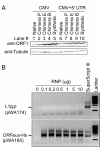Characterization of a synthetic human LINE-1 retrotransposon ORFeus-Hs
- PMID: 21320307
- PMCID: PMC3045867
- DOI: 10.1186/1759-8753-2-2
Characterization of a synthetic human LINE-1 retrotransposon ORFeus-Hs
Abstract
Long interspersed elements, type 1(LINE-1, L1) are the most abundant and only active autonomous retrotransposons in the human genome. Native L1 elements are inefficiently expressed because of a transcription elongation defect thought to be caused by high adenosine content in L1 sequences. Previously, we constructed a highly active synthetic mouse L1 element (ORFeus-Mm), partially by reducing the nucleotide composition bias. As a result, the transcript abundance of ORFeus-Mm was greatly increased, and its retrotransposition frequency was > 200-fold higher than its native counterpart. In this paper, we report a synthetic human L1 element (ORFeus-Hs) synthesized using a similar strategy. The adenosine content of the L1 open reading frames (ORFs) was reduced from 40% to 27% by changing 25% of the bases in the ORFs, without altering the amino acid sequence. By studying a series of native/synthetic chimeric elements, we observed increased levels of full-length L1 RNA and ORF1 protein and retrotransposition frequency, mostly proportional to increased fraction of synthetic sequence. Overall, the fully synthetic ORFeus-Hs has > 40-fold more RNA but is at most only ~threefold more active than its native counterpart (L1RP); however, its absolute retrotransposition activity is similar to ORFeus-Mm. Owing to the elevated expression of the L1 RNA/protein and its high retrotransposition ability, ORFeus-Hs and its chimeric derivatives will be useful tools for mechanistic L1 studies and mammalian genome manipulation.
Figures




References
-
- Fanning TG, Singer MF. LINE-1: a mammalian transposable element. Biochim Biophys Acta. 1987;910:203–212. - PubMed
LinkOut - more resources
Full Text Sources
Other Literature Sources
Research Materials

